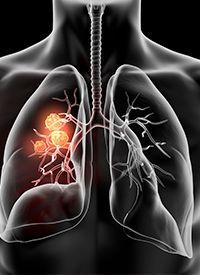Article
Ivonescimab Gets Breakthrough Therapy Designation in China for EGFR+ Advanced NSCLC
Author(s):
The China National Medical Products Administration has granted a breakthrough therapy designation to ivonescimab for use in combination with chemotherapy in patients with EGFR-mutated advanced non–small cell lung cancer in whom prior treatment with an EGFR TKI has failed.

The China National Medical Products Administration’s Center for Drug Evaluation has granted a breakthrough therapy designation to the PD-1/VEGF bispecific antibody, ivonescimab (AK112), for use in combination with chemotherapy in patients with EGFR-mutated advanced non–small cell lung cancer (NSCLC) in whom prior treatment with an EGFR TKI has failed.1
The agent blocks PD-1 from binding to PD-L1 and PD-L2, as well as the binding of VEGF to VEGFR receptors. Previous studies have found that the combination of PD-1 antibodies and VEGF-blocking drugs can have strong efficacy spanning several cancers, including NSCLC. Because VEGF and PD-1 are co-expressed in the tumor microenvironment, and ivonescimab blocks those 2 targets, investigators hypothesize that the agent may be able to provide stronger antitumor activity than combination therapy.
In a previous open-label, multicenter phase 2 trial (NCT04736823), investigators evaluated the combination of ivonescimab and chemotherapy in patients with advanced NSCLC.2 Those enrolled to the trial will divided into 3 cohorts: those with NSCLC who did not harbor EGFR or ALK alterations (cohort 1), those with EGFR-mutated NSCLC in whom previous EGFR TKI therapy has failed (cohort 2), and those with NSCLC in whom previous platinum-based chemotherapy and anti–PD-1 therapy has failed (cohort 3).
Those in cohort 1 received ivonescimab in combination with pemetrexed at 500 mg/m2 if they had nonsquamous disease (n = 25) or paclitaxel at 175 mg/m2 if they had squamous disease (n = 18) and carboplatin at area under the curve 5 mg per min/mL. In cohort 2 (n = 19), ivonescimab was administered in combination with pemetrexed at 500 mg/m2 and carboplatin AUC 5 mg at min/mL. Lastly, those in cohort 3 (n = 20) were given ivonescimab plus docetaxel at 75 mg/m2.
The primary end points of the trial were safety and tolerability, as well as objective response rate (ORR) by RECIST v1.1 criteria.
From February 3, 2021, to March 20, 2022, a total of 83 patients were enrolled to the 3 cohorts, and all had received at least 1 dose of ivonescimab in combination with chemotherapy.
Across the cohorts, the median age of patients was 58.03 years (range, 31.6-73.4). Moreover, 60.2% of patients were male, 90.4% had an ECOG performance status of 1, 51.8% were former or current smokers, 91.6% had stage IV disease at study entry, and 19.3% had brain metastasis. Regarding PD-L1 tumor proportion score, 43.4% had a score of less than 1%, 36.1% had a score ranging from 1% to 49%, 15.7% had a score of 50% or higher, and 4.8% were not evaluable.
The median duration of follow-up for cohorts 1, 2, and 3 were 9.2 months (range, 7.7-9.7), 7.0 months (range, 5.6-7.1), and 5.9 months (range, 4.4-6.9), respectively.
Data showed that those in cohort 1 who had squamous disease experienced an ORR of 77.8% (95% CI, 52.4%-93.6%) and a disease control rate (DCR) of 100.0% (95% CI, 81.5%-100.0%); the ORR was lower in those with nonsquamous disease in this cohort, at 52.0% (95% CI, 31.3%-72.2%) but the DCR was also 100.0% (95% CI, 86.3%-100.0%). The median progression-free survival (PFS) was not yet reached, and the 6-month PFS rate was 78.8% (95% CI, 63.2%-88.4%).
In cohort 2, the ORR was 68.4% (95% CI, 43.4%-87.4%) and the DCR was 94.7% (95% CI, 74.0%-99.9%). Here, the median PFS was 8.2 months (95% CI, 5.5-not evaluable [NE]), and the PFS rate at 6 months was 69.3% (95% CI, 40.6%-86.2%). In cohort 3, the ORR and DCR were 40.0% (95% CI, 19.1%-63.9%) and 80.0% (95% CI, 56.3%-94.3%), respectively. The median PFS was 6.6 months (95% CI, 2.3-NE) in this cohort, with a 6-month PFS rate of 51.1% (95% CI, 24.4%-72.7%).
In the full population of 83 patients, 85.5% experienced a treatment-related adverse effect (TRAE), with 24.1% experiencing an effect that was grade 3 to 5. Moreover, 18.1% of patients experienced treatment-related serious AE.
The most frequently experienced TRAEs included increased alanine aminotransferase (20.5%), increased aspartate aminotransferase (18.1%), anemia (15.7%), increased amylase (14.5%), decreased white blood cell count (14.5%), decreased neutrophil count (12.0%), epistaxis (12.0%), and decreased platelet count (10.8%).
Hemorrhage-related AEs of special interest included epistaxis (12.0%), hemoptysis (6.0%), hematuria (1.2%), hematochezia (1.2%), gingival bleeding (1.2%), anal hemorrhage (1.2%), and conjunctival hemorrhage (1.2%).
No significant difference in the incidence of TRAEs between those with squamous and nonsquamous disease was observed.
TRAEs led to discontinuation of ivonescimab in 3.6% of patients, and 1.2% experienced a TRAE that resulted in death.
A double-blind, randomized, multicenter phase 3 trial is now examining ivonescimab in combination with chemotherapy compared with placebo and chemotherapy in patients with locally advanced or metastatic nonsquamous NSCLC and an EGFR mutation in whom an EGFR TKI has failed.3 In January 2022, the first patient was dose on the trial.
References
- Akeso’s ivonescimab (PD-1/VEGF BsAbs) granted breakthrough therapy designation by China NMPA for the treatment of advanced NSCLC. News release. Akeso, Inc. October 20, 2022. Accessed October 21, 2022. https://prn.to/3gt6Oap
- Zhao, Y, Fang W, Yang Y, et al. A phase II study of AK112 (PD-1/VEGF bispecific) in combination with chemotherapy in patients with advanced non-small cell lung cancer. J Clin Oncol. 2022;40(suppl 16):9019. doi:10.1200/JCO.2022.40.16_suppl.9019
- Akeso doses first patient in the phase III trial of ivonescimab combined with chemotherapy in EGFR-TKI resistant EGFR mutation advanced non-squamous non-small cell lung cancer. News release. Akeso, Inc. January 30, 2022. Accessed October 21, 2022. https://prn.to/3F56WHu








